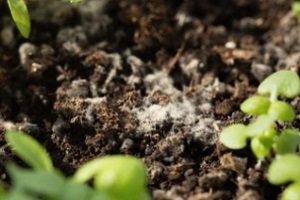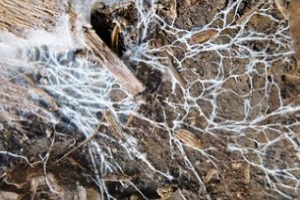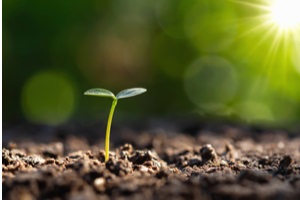Discovering mold on your soil can be disconcerting, but there are several ways that you can remedy the situation. Although many types of mold are considered relatively harmless, getting rid of it is simple and straightforward. Here is a look at some of the best methods of dealing with this problem.
Dry Out the Potting Soil
 Mold thrives in damp soil, so it is important to make sure your house plants do not stay too wet. Overwatering plants is one of the top causes of mold in potting soil. If you place your plant’s soil in direct natural sunlight, its ultraviolet rays should kill the mold entirely.
Mold thrives in damp soil, so it is important to make sure your house plants do not stay too wet. Overwatering plants is one of the top causes of mold in potting soil. If you place your plant’s soil in direct natural sunlight, its ultraviolet rays should kill the mold entirely.
There are two ways you use the sun to kill mold on soil. First, you can simply move the plant into a sunny spot outdoors and leave the sun to work its magic. Because mold is typically found only on the surface of the soil, this should get the job done. You may even remove the top layer of the soil where the mold is growing and throw it away before you set the houseplant outside for a while.
Another option is to remove your plant from its container and spread the soil out in a sunny spot. This is the best course of action if the plant itself is sensitive to direct exposure to the sun as it allows you to address your mold problem without putting your plant at risk. If you choose this approach, you can spray the soil with a mixture of water and baking soda while it is sitting in the sun as the baking soda will help to draw the moisture out of the mold and absorb it and help reduce the chances it will return in the future.
Repot the Plant
Although placing a plant in the sun can address mold problems quite effectively, there is a chance it could return. If you have a smaller plant and spare soil, you might wish to repot it using fresh and sterile soil to get rid of the problem entirely. All you need to do is remove the houseplant from its pot, clean out the container thoroughly, and refill it using fresh, sterile soil. If desired, you can spray the container lightly with a fungicide before you refill it.
Before replanting, be sure to rinse off the roots and clean mold off the leaves as any lingering mold spores could lead to recontamination.
Once you have repotted the plant, you need to consider making some changes to prevent mold from growing again. For example, if your watering and care routine is poor, you are likely to encounter more mold in the future. Review your plant’s requirements and adapt your watering and care routine as needed.
Use a Natural Antifungal
 If mold is a recurring problem, you might want to add a natural antifungal to your houseplant’s soil. Sometimes, despite your best efforts to give it proper sunlight and avoid overwatering, it can be difficult to keep mold and fungus entirely at bay. This is particularly true if you live in an area that is often cold and damp.
If mold is a recurring problem, you might want to add a natural antifungal to your houseplant’s soil. Sometimes, despite your best efforts to give it proper sunlight and avoid overwatering, it can be difficult to keep mold and fungus entirely at bay. This is particularly true if you live in an area that is often cold and damp.
Thankfully, it is easy to add natural antifungals to your soil to help avoid this problem. There are several things you can add to the soil to address mold that will not harm your houseplant, such as apple cider vinegar, baking soda or cinnamon. Simply mix them into your soil or sprinkle them across the surface of the soil. Just a few sprinkles or spoons for each plant is enough to address the problem.
Ways to Prevent Mold In House Plants
Although these are some effective ways of getting rid of mold in your soil, it is also important to make sure that you are preventing mold from occurring in the first place. Here are some tips.
Adjust Your Watering Schedule
The best approach to watering house plants is to ensure you are only doing so when the top layer of soil is dry. You can check this by touching the top of the soil and pushing your finger into it. If the top two inches are dry, it is time to water the plant. Of course, some plants prefer that their soil dries out completely between waterings, so check the specific instructions for the type of plant in question.
When you are watering your plants, allow water to drain out through the drainage holes and empty the plate underneath the pot after a couple minutes have passed so the plant does not sit for too long in excess water.
Help Your Plants Get More Light
 Mold thrives in dark and damp places, so brightening up the area where you keep your houseplant can make a big difference. Open your curtains and blinds during the day and position your plants near windows so that sun will shine on their soil. Some plants do not do well with a lot of direct sunlight, so be sure to check what your specific plant’s needs are and ensure that you do not exceed its limits.
Mold thrives in dark and damp places, so brightening up the area where you keep your houseplant can make a big difference. Open your curtains and blinds during the day and position your plants near windows so that sun will shine on their soil. Some plants do not do well with a lot of direct sunlight, so be sure to check what your specific plant’s needs are and ensure that you do not exceed its limits.
If your plants need more light and leaving them in a bright room with indirect sunlight is not an option, consider moving them temporarily to a sunny window or outdoors during sunny hours.
Increase Ventilation
Good ventilation can help prevent mold growth, so place your house plants in a room that has good air circulation. You can also open up windows or use a basic oscillating fan on a low setting every couple of days to keep the air circulating in the room where you keep your plants.
Get in Touch With Dirt Connections
Having the right soil can go a long way toward eliminating common problems like mold and drainage issues. At Dirt Connections, we supply Northern Virginia and the surrounding area with high-quality topsoil, fill dirt and other types of dirt for a range of projects. Get in touch today to learn more about our soil and dirt delivery services.
Summary

Dirt Connections was started with one goal in mind: providing quality residential and commercial construction services to clients on time and on budget. Reach out for more information on how we can support your next project.
For your convenience our estimates are free and by appointment. Call 703-940-9949 for a free estimate today!










































